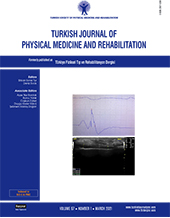Comparing the efficacy of continuous and pulsed ultrasound therapies in patients with lateral epicondylitis: A double-blind, randomized, placebo-controlled study
2 Department of Physical Medicine and Rehabilitation, Eskişehir Osmangazi University, Faculty of Medicine, Eskişehir, Turkey DOI : 10.5606/tftrd.2021.4789 Objectives: The aim of this study was to investigate the efficacy of continuous and pulsed ultrasound therapies in lateral epicondylitis.
Patients and methods: A total of 51 patients (18 males, 33 females; mean age: 46.52±6.16 years; range, 27 to 64 years) who were diagnosed with lateral epicondylitis between February 2013 and October 2014 were included. The patients were randomized to either continuous ultrasound (n=17), pulsed ultrasound (n=17), or placebo (n=17) groups. First group received 10 sessions of continuous ultrasound therapy. The second group received 10 sessions of pulsed ultrasound therapy in a ratio of 1:4. The third group received 10 sessions of placebo treatment. The pain levels of the patients were evaluated using Visual Analog Scale (VAS). The muscle strength was evaluated using a dynamometer. For functional evaluation, Duruöz`s Hand Index (DHI) and Patient-Rated Tennis Elbow Evaluation (PRTEE) scales were used. Assessments were made at baseline, at the end of therapy, and one month after therapy. The thickness of the common extensor tendon was also measured using ultrasonic imaging at baseline and at the end of therapy.
Results: At the end of the study, there was a statistically significant improvement in the rest and activation VAS scores, and DHI and PRTEE scores in both continuous and pulsed ultrasound therapy groups, compared to placebo (p<0.05). However, no superiority was found between the continuous and pulsed ultrasound therapy groups (p>0.05). A statistically significant reduction in the common extensor tendon thickness was found only in the pulsed ultrasound therapy group (p<0.05).
Conclusion: Our study results show that both continuous and pulsed ultrasound applications are effective in the treatment of lateral epicondylitis.
Keywords : Lateral epicondylitis, pulsed ultrasound, therapeutic ultrasound

















